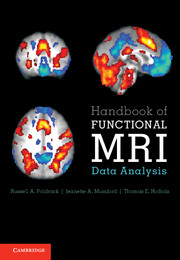Book contents
- Frontmatter
- Contents
- Preface
- 1 Introduction
- 2 Image processing basics
- 3 Preprocessing fMRI data
- 4 Spatial normalization
- 5 Statistical modeling: Single subject analysis
- 6 Statistical modeling: Group analysis
- 7 Statistical inference on images
- 8 Modeling brain connectivity
- 9 Multivoxel pattern analysis and machine learning
- 10 Visualizing, localizing, and reporting fMRI data
- Appendix A A Review of the General Linear Model
- Appendix B Data organization and management
- Appendix C Image formats
- Bibliography
- Index
6 - Statistical modeling: Group analysis
Published online by Cambridge University Press: 01 June 2011
- Frontmatter
- Contents
- Preface
- 1 Introduction
- 2 Image processing basics
- 3 Preprocessing fMRI data
- 4 Spatial normalization
- 5 Statistical modeling: Single subject analysis
- 6 Statistical modeling: Group analysis
- 7 Statistical inference on images
- 8 Modeling brain connectivity
- 9 Multivoxel pattern analysis and machine learning
- 10 Visualizing, localizing, and reporting fMRI data
- Appendix A A Review of the General Linear Model
- Appendix B Data organization and management
- Appendix C Image formats
- Bibliography
- Index
Summary
Whereas the previous chapter focused on analyzing the data from a single run for a single subject, this chapter focuses on how we combine the single subject results to obtain group results and test group hypotheses. The most important consideration of the group fMRI model is that it accounts for the so-called repeated measures aspect of the data, which means that subjects are randomly sampled from a larger population, and multiple fMRI measurements are obtained for each subject. If the proper model is not used, inferences will only apply to the particular subjects in the study, as opposed to the population from which they were sampled. In general, it is important that subjects are treated as random effects in the model, which is known as a mixed effects model. The difference between treating subjects as random versus fixed quantities is discussed in the following section.
The mixed effects model
Motivation
To motivate the need for a mixed effects analysis, we use a simple example from outside of the imaging domain. Instead of measuring brain activity for a subject, imagine that we measure hair length. The goal is to see if there is a difference in the length of hair between men and women and since we clearly cannot measure hair length on all people we randomly sample from the population. Once we know the distributions of hair length for men and women, they can be compared statistically to see if there is a difference.
Information
- Type
- Chapter
- Information
- Handbook of Functional MRI Data Analysis , pp. 100 - 109Publisher: Cambridge University PressPrint publication year: 2011
